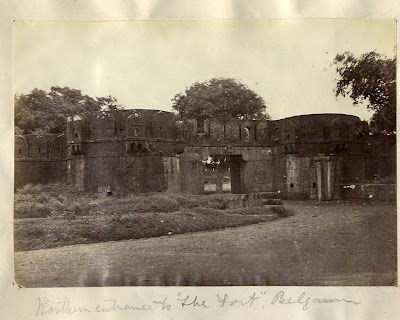 The Blog was viewed more then 10000 Times by our readers, since 15th Dec 2007. Your kind co-operation was really necessary for making my blog a big success.
The Blog was viewed more then 10000 Times by our readers, since 15th Dec 2007. Your kind co-operation was really necessary for making my blog a big success.
Temple Belgaum
One more great news is Google Maps has updated my comments of changing the icon of the Jain temples from a normal temple icon to a Jain hand symbol as shown below. A heart-full thanks to Google from all Jain community.
Ahimsa Hand:
 |
| Jamia Masjid as seen in 1910 |
ABB Says : With inputs from Bramhanand Chipre – http://kamalbasti.blogspot.com/
Source : http://allaboutbelgaum.com/
Today'as Missing Temples as seen in the Fort of Belgaum in 1860
Posted in Belgaum, Belgaum Fort, Missing temples, Temple
Lead Half Karshapana of Kuras of Belgaum/Kohlapur 30BC - 65AD RARE
Ruler : King Vasithiputra
Year : 30 BC - 65 AD
Units : Pb (lead) Karshapana, 20mm 3.4gm
Obverse : Bow & Arrow, legend in Brahmi: Siri Vasisthiputrasa
Reverse : Tree in railing on right; Multi arched hill on left
The south west region was ruled by the Kuras during the 1st century AD and they were the major power. Brahmapuri and Madhavapur (Kolhapur and Belgaum) were the two major seats. Some of the military achievements over Chutus show the influence of Chutus in their coinage. They mainly ruled between 30 BC and 65 AD as could be understood by the victory of Nahapana over Kuras. The King Vilivayukura is even quoted in Ptolemy's work and seems to be the last king who was defeated by the Satavahanas giving way for Chutus to circulate their coins in this area. All the coins minted by the Kuras were in lead. The bow and arrow decorated the coin obverse and the reverse of their coinage usually carried Chaitya, railed tree and river symbols along with the Brahmi legend along the periphery.
Lead Half Karshapana of Kuras of Belgaum/Kohlapur 30BC - 65AD, Overstruck, Lion facing right RARE
Year : 30 BC - 65 AD
Unit : Pb (lead) Karshapana, 20mm 5.3gm
Obverse : Overstruck, Lion facing right, legend in Brahmi
Reverse : Tree in railing on right;
Reference: Unpublished
The south west region was ruled by the Kuras during the 1st century AD and they were the major power. Brahmapuri and Madhavapur (Kolhapur and Belgaum) were the two major seats. Some of the military achievements over Chutus shows the influence of Chutus in their coinage. They mainly ruled between 30 BC and 65 AD as could be understood by the victory of Nahapana over Kuras. The King Vilivayukura is even quoted in Ptolemy's work and seems to be the last king who was defeated by the Satavahanas giving way for Chutus to circulate their coins in this area. All the coins minted by the Kuras were in lead. The bow and arrow decorated the coin obverse and the reverse of their coinage usually carried Chaitya, railed tree and river symbols along with the Brahmi legend along the periphery.

Ruler : King Vasithiputra
Year : 30 BC - 65 AD
Unit : Pb (lead) Karshapana,30mm 18.4gm
Obverse : Bow & Arrow, legend in Brahmi:Siri Vasisthiputrasa
Reverse : Tree in railing on right; Multi arched hill on left
Reference : TA#014, RRR
The south west region was ruled by the Kuras during the 1st century AD and they were the major power. Brahmapuri and Madhavapur (Kolhapur and Belgaum) were the two major seats. Some of the military achievements over Chutus shows the influence of Chutus in their coinage. They mainly ruled between 30 BC and 65 AD as could be understood by the victory of Nahapana over Kuras. The King Vilivayukura is even quoted in Ptolemy's work and seems to be the last king who was defeated by the Satavahanas giving way for Chutus to circulate their coins in this area. All the coins minted by the Kuras were in lead. The bow and arrow decorated the coin obverse and the reverse of their coinage usually carried Chaitya, railed tree and river symbols along with the Brahmi legend along the periphery.
This Time Around . . . .
Spying
Blog Archive
- December 2007 (5)
- April 2008 (2)
- June 2008 (3)
- July 2008 (1)
- August 2008 (1)
- February 2009 (1)
- March 2009 (5)
- August 2009 (1)
- December 2009 (4)
- January 2010 (2)
- February 2010 (14)
- March 2010 (1)
- April 2010 (6)
- May 2010 (2)
- July 2010 (3)
- September 2010 (1)
- October 2010 (1)
- March 2011 (3)
Belgaum Latest News
- All About Belgaum
- Belgaum Encyclopedia
- Belgaums Blog made for NRIs
- Belgaums Latest News
- Ekavi Belgaum
- Kamal Basadi as described by Cantonment Belgaum
- Kamal Basadi as described by Naushad Bijapur
- Kamal Basti as described by Misty of NJ, USA
- Kamal Basti as described by MP3 Travel
- Kannadamma Daily
- ನಮ್ಮ ಬೆಳಗಾವಿ, ಹುಬ್ಬಳ್ಳಿ ಮತ್ತು ಧಾರವಾಡದ ಸುದ್ದಿಗಳು
Calendar
Indian Time Zone
Chatter Pox
Kamal Basadi on Map
Visitors Check
Source Links
Jain Facts
Categories
- Bamboo village
- Bangalore
- Belgaum
- Belgaum Fort
- Brahmapuri
- Chikki Basti
- Fort
- Fort Lake
- Gokak
- HUbli
- Jain
- Jainism
- Kamal Basti
- Kamala Basti
- Karnataka Tourism
- Kolhapur
- Kotekere
- Kuras
- Madhavapur
- Malenadu
- Maratha Mandal
- Missing temples
- Navagrah
- Parswanath
- Pune
- Rani Chennama
- Sangoli
- Sugar Bowl
- Temple
- Varur
- Venugrama
- VRL
Jain Books

























